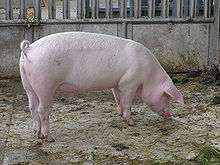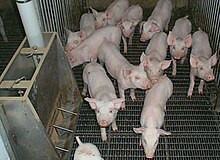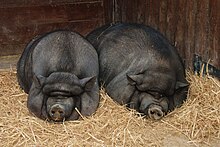Pig
This article needs additional citations for verification. (September 2007) |
This animal-related article may require cleanup to conform to a higher standard of quality. |
| Domestic Pig | |
|---|---|

| |
| A domestic pig on an organic farm in Solothurn, Switzerland | |
Domesticated
| |
| Scientific classification | |
| Kingdom: | |
| Phylum: | |
| Class: | |
| Order: | |
| Family: | |
| Genus: | |
| Species: | |
| Subspecies: | S. s. domestica
|
| Trinomial name | |
| Sus scrofa domestica Linnaeus, 1758
| |
| Synonyms | |
|
| |
The domestic pig (or in some areas hog) is normally given the scientific name Sus scrofa scrofa, though some taxonomists use the term S. domestica, reserving S. scrofa for the wild boar.
Pigs are believed to have been domesticated from wild boar as early as 9000 BC in the Near East and separately in China at about the same time[1]. DNA evidence from sub-fossil remains of teeth and jawbones of Neolithic pigs in Europe shows that the first domestic pigs there had been brought from the Near East. It appears that this stimulated the domestication of European wild boar, effectively forming a third domestication event – the Near Eastern genes later died out in European pigs, and domesticated European pigs were then exported in turn to the ancient Near East[2].
The adaptable nature and omnivorous diet of the wild boar allowed early humans to domesticate it readily. Pigs were mostly used for food, but early civilizations also used the pigs' hides for shields, bones for tools and weapons, and bristles for brushes.[3] Pigs were brought to southeastern North America from Europe by De Soto and other early Spanish explorers. Escaped pigs became feral and were used by Native Americans as food.[4]
Most domestic pigs have rather sparse hair covering on their skin, although woolly coated breeds are known (Mangalitsa pig), and some were popular in the past. [5] Escaped domestic pigs have become feral in many parts of the world (for example, New Zealand) and have caused substantial environmental damage. [6] [7]
Food




The domestic pig is used for its meat, called pork. Other products made from pigs include sausage, bacon, gammon, ham and pork scratchings. The head of a pig can be used to make a preserved jelly called head cheese. Liver, chitterlings, and other offal from pigs are also widely used for food. In some religions, such as Judaism and Islam, there are religious restrictions on the consumption of pork.
Farming
In developing nations, and often in developed nations, the domestic pig is raised outdoors in yards or fields. In some cases pigs are allowed to forage in woods, where they are watched by swineherds, the equivalent of shepherds for pigs. In industrialized nations, domestic pig farming has shifted away from the traditional pig farm to large-scale intensive pig farms where meat can be mass-produced. This has resulted in lower production costs, but more significant animal welfare concerns.
Animal welfare, animal health, food safety, and the environment are some of the main factors pork producers consider. Producers’ livelihoods depend on using the best management practices to ensure the well-being and performance of their animals.
Individual farm management practices focus on, among other things, housing facilities, feeding and ventilation systems, and temperature and environmental controls. Just as producers have to determine the type of facilities and equipment for their farm, they must find the practices that best fit their farm’s specific situation. Some procedures and treatments can be short-term stressors, so producers must weigh the long-term welfare, health and management benefits to the animals.
Using the knowledge obtained from scientific study, some producers have adopted and adapted techniques and husbandry skills to protect the welfare of their animals. They feel a personal and moral responsibility to take care of their animals and ensure that the animals are safe, but they also must earn a profit from their business. They consider anything short of providing the best, humane care possible as being self-defeating.
Unfortunately, poor husbandry practices can still be found at the farm level. Abuses have been reported in the industry where pigs suffer unnecessary stress. Some would also say that housing systems, called gestation stalls, used for sows are a form of abuse. There are many different types of acceptable housing types in use for housing gestating sows in today's U.S. pork industry. These housing types usually fit in one of two categories:
* Individual housing * Group housing
The American Veterinary Medical Association (AVMA) and the American Association of Swine Veterinarians (AASV) have reviewed existing scientific literature on gestational sow housing and have published position statements that concluded that both types of housing types have advantages and disadvantages.
The individual housing category includes the individual stall system. In this system, sows are housed in a structure large enough for one sow. There are variations in stall designs. Some of the advantages of individual housing include:
* minimize aggression and injury among sows * reduce competition for resources * allow individual feeding * assist in the control of body condition sow sows to not become too thin or too fat * provide for the safety of the worker
Some of the disadvantages of individual housing include:
* restriction of movement and exercise * restricts ability to perform foraging behaviors * sows have limited social interaction
In the other housing category, sows are housed in groups. Group sizes may range from five sows per pen up to more than 100 sows per pen. Free access stalls, trickle feeding, electronic sow feeding stations and deep bedded systems are just a few of the many different variations in group housing systems in use. Some of the advantages of group housing include:
* freedom of movement and exercise * social interaction
Some of the potential disadvantages of group housing include:
* aggression and injury * uneven body conditions * inability to forage if no manipulable materials are present
There are many factors that contribute to the success of a particular type of housing system. Studies have concluded the success of housing systems may be dependent in great measure to the caretaker's husbandry skills.
The AVMA and AASV have concluded that regardless of the type of housing system in use, the system should:
* minimize aggression and competition among sows; * protect sows from detrimental effects associated with environmental extremes, particularly temperature extremes; * reduce exposure to hazards that result in injuries, pain, or disease; * provide every animal with daily access to appropriate food and water; * facilitate observation of individual sow appetite, respiratory rate, urination and defecation, and reproductive status by caregivers; and * allow sows to express most normal patterns of behavior
There are also reported instances of employees engaging in deliberate animal cruelty toward the pigs. These practices are not supported or encouraged by responsible pork producers.
Pigs that do not receive proper care grow more slowly, have higher mortality rates, and require more veterinary treatment. A market for pork historically has been assumed, but sales are shifting toward pork derived from pigs raised under humane conditions. Pigs that cannot be marketed generate only expense, not income.
Uses in truffle hunting
The domestic pig is also widely used in France and other countries to search for truffles. This is because the truffle smells similar to the pheromones of the animal.[citation needed]
As pets
Pigs are known to be intelligent animals and have been found to be more trainable than dogs or cats. [8] Asian pot-bellied pigs, a small type of domestic pig, have made popular house pets in the United States beginning in the latter half of the 20th century. Regular domestic farmyard pigs have also been known to be kept indoors, but due to their large size and destructive tendencies, they typically need to be moved into an outdoor pen as they grow older. Most pigs have a fear of being picked up, but will usually calm down once placed back on the floor. Pigs are rarely used as working animals. An exception is the use of truffle pigs – ordinary pigs trained to find truffles.
Breeds of pigs
Pigs are exhibited at agricultural shows, judged either as stud stock compared to the standard features of each breed, or in commercial classes where the animals are judged primarily on their suitability for slaughter to provide premium meat.
Rare pig breeds
According to the American Livestock Breeds Conservancy [9], seven breeds of swine in the U.S. are critically rare (having a global population of fewer than 2000). Outside the U.S., the Auckland Island Pig (New Zealand) and woolly-coated grazing pig (Danube area) are known to be critically rare. Rare U.S. breeds include:
- Gloucestershire Old Spots (technically a U.K. rare breed).
- Mulefoot
- Red Wattle
...
Pig farming terminology
Types of animal
| Global pig stock | |
|---|---|
| in 2005 | |
| Number in millions | |
| 1. | 488.8 (50.87%) |
| 2. | 60.4 (6.29%) |
| 3. | 33.2 (3.46%) |
| 4. | 27 (2.81%) |
| 5. | 26.9 (2.8%) |
| 6. | 25.3 (2.63%) |
| 7. | 18 (1.87%) |
| 8. | 15 (1.56%) |
| 9. | 14.7 (1.53%) |
| 10. | 14.6 (1.52%) |
| World total | 960.8 |
| Source: UN Food and Agriculture Organization | |
- Pig, either the species as a whole, or where the species is called "hog", only young piglets.
- Swine, either the species as a whole, or any member of it. The singular is the same as the plural.
- Shoat, piglet or (where the species is called "hog") pig, unweaned young pig, or any immature pig.
- Sucker, a pig between birth and weaning.
- Runt, an unusually small and weak piglet, often one in a litter.
- Boar or hog, male pig of breeding age.
- Barrow, male pig castrated before puberty.
- Stag, male pig castrated later in life, (that is, an old boar after castration).
- Gilt, young female not yet mated, or not yet farrowed, or after only one litter (depending on local usage).[10]
- Sow, breeding female, or female after first or second litter.
Pigs for slaughter
- Suckling pig, a piglet slaughtered for meat.
- Feeder pig, a weaned gilt or barrow weighing between 18 kg (40 lb) and 37 kg (82 lb) at 6 to 8 weeks of age that is sold to be finished for slaughter.
- Porker, market pig between 30 kg (66 lb) and about 54 kg (119 lb) dressed weight.
- Baconer, a market pig between 65 kg (143 lb) and 80 kg (180 lb) dressed weight. The maximum weight can vary between processors.
- Grower, a pig between weaning and sale or transfer to the breeding herd, sold for slaughter or killed for rations[clarification needed].
- Finisher, a grower pig over 70 kg (150 lb) liveweight.
- Butcher hog, a pig of approximately 100 kg (220 lb), ready for the market.
- Backfatter, cull breeding pig sold for meat; usually refers specifically to a cull sow, but is sometimes used in reference to boars.
Groups
- Herd, a group of pigs, or all the pigs on a farm or in a region.
- Sounder, a small group of pigs (or wild boar) foraging in woodland.
Pig parts

- Trotters, the feet of pigs (they have four hoofed toes, walking mainly on the larger central two).
Biology
- In pig, pregnant.
- Farrowing, giving birth.
- Hogging, a sow when on heat (during oestrus).
Housing
- Sty, a small pig-house, usually with an outdoor run.
- Pig-shed, a larger pig-house.
- Ark, a low field-shelter for pigs (or other animals such as rabbits or chickens).
See also
- ECODIPTERA
- Exotic pet
- Extensive farming
- Factory farming
- Intensive farming
- Intensive pig farming
- Taboo meat
- List of domestic pig breeds
Notes
- ^ Giuffra E, Kijas JM, Amarger V, Carlborg O, Jeon JT, Andersson L. The origin of the domestic pig: independent domestication and subsequent introgression., April 2000, Template:En icon.
- ^ BBC News, "Pig DNA reveals farming history" 4 September 2007. The report concerns an article in the journal PNAS
- ^ http://www.flossybrush.ca/oral.html Oral Care.
- ^ http://www.cambridge.org/us/books/kiple/hogs.htm II.G.13. - Hogs.
- ^ http://www.malverngazette.co.uk/mostpopular.var.1476623.mostviewed.royal_visit_delights_at_the_three_counties_show.php Royal visit delights at the Three Counties Show.
- ^ http://query.nytimes.com/gst/fullpage.html?res=9E0CEED6103CF93AA15751C1A964958260&sec=&spon=&pagewanted=all Alien Species Threaten Hawaii's Environment.
- ^ http://www.nzetc.org/tm/scholarly/tei-Bio27Tuat02-t1-body-d1.html Introduced Birds and Mammals in New Zealand and Their Effect on the Environment.
- ^ http://www.rps.psu.edu/probing/pigs.html Are pigs smarter than dogs?
- ^ American Livestock Breeds Conservancy. Retrieved 18 April 2008.
- ^ Swine Study Guide from UC Davis
References
- Template:IUCN2006
- The Humane Society of the United States
- Factory Farming Photo Gallery
- Factory Pork Production
- Animal Welfare AVMA Policy on Pregnant Sow Housing
- CAST Scientific Assessment of the Welfare of Dry Sows kept in Individual Accommodations- March 2009
